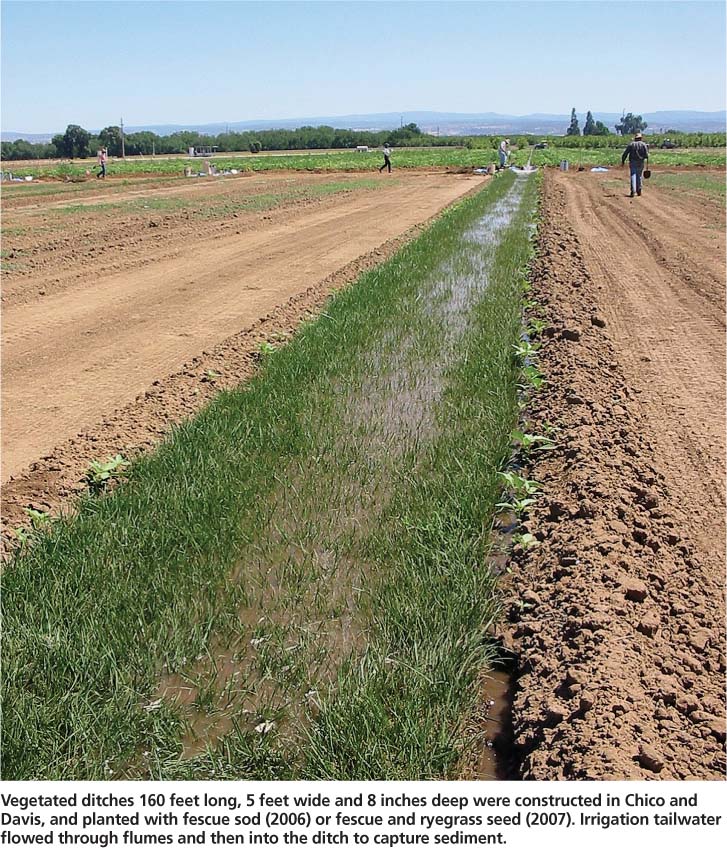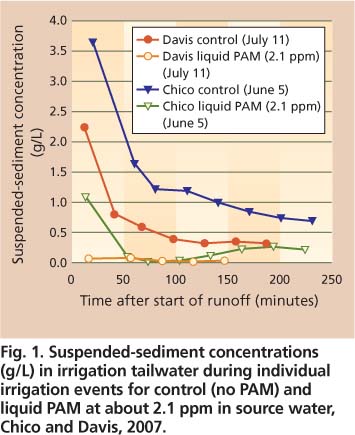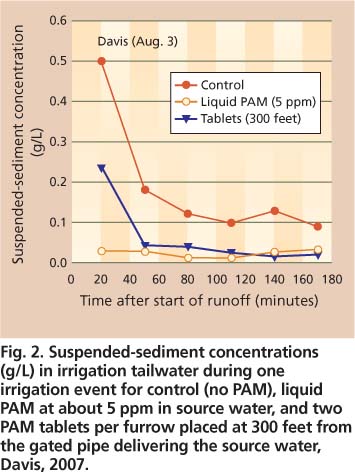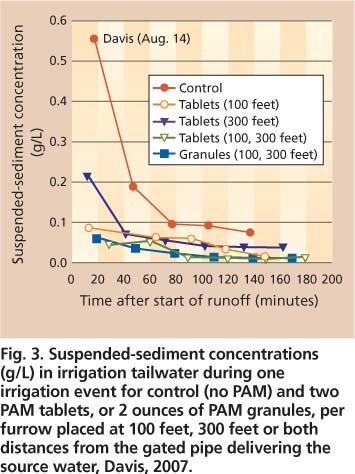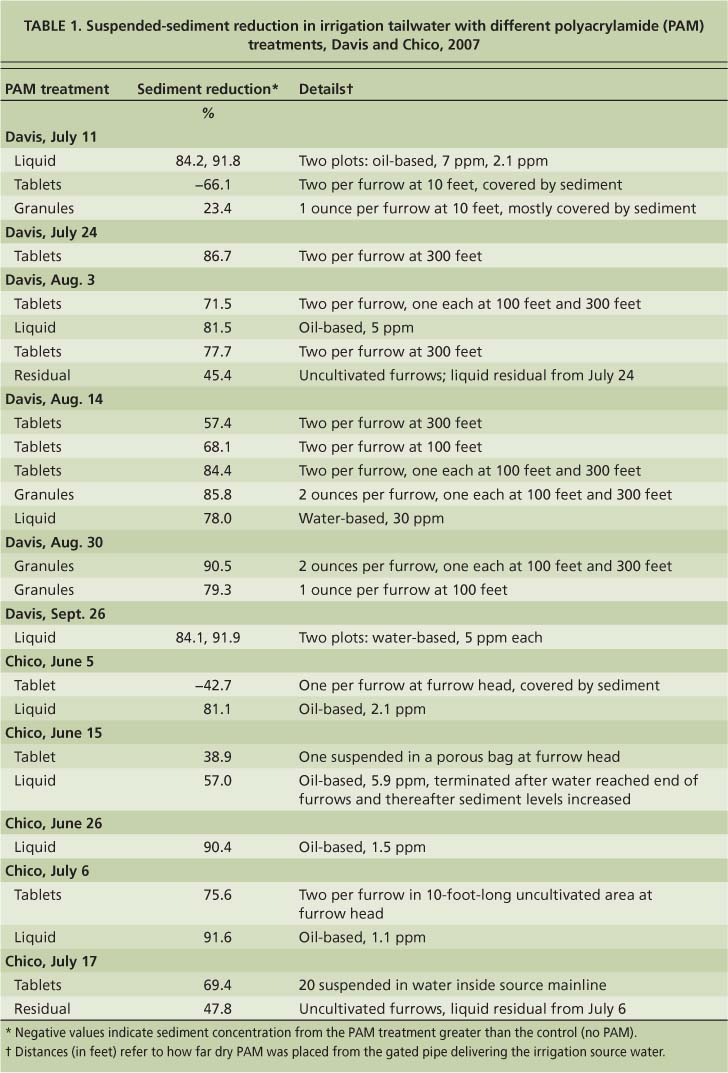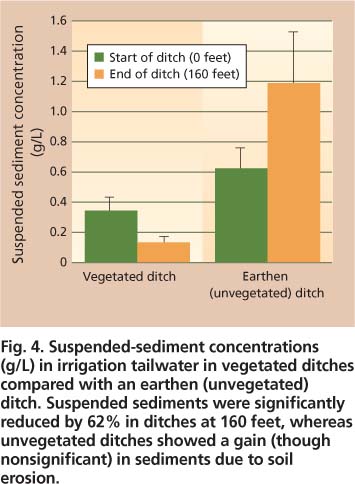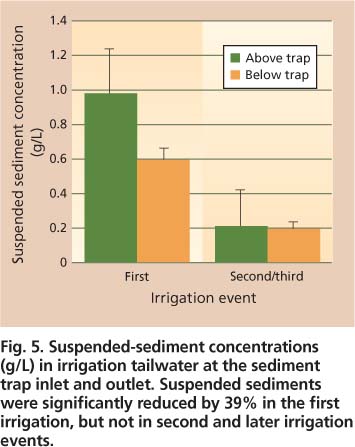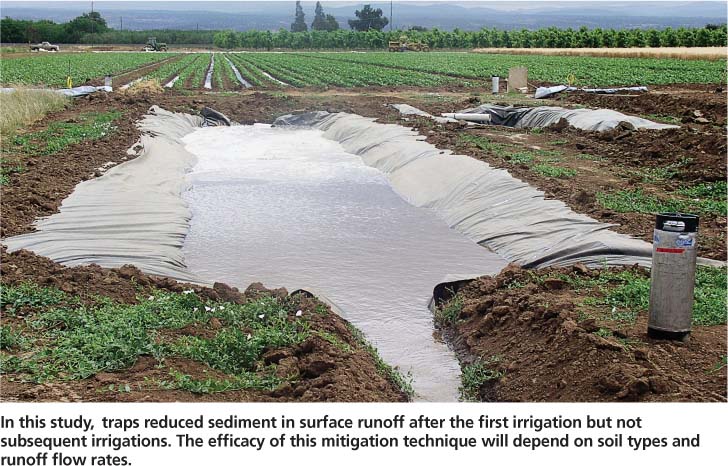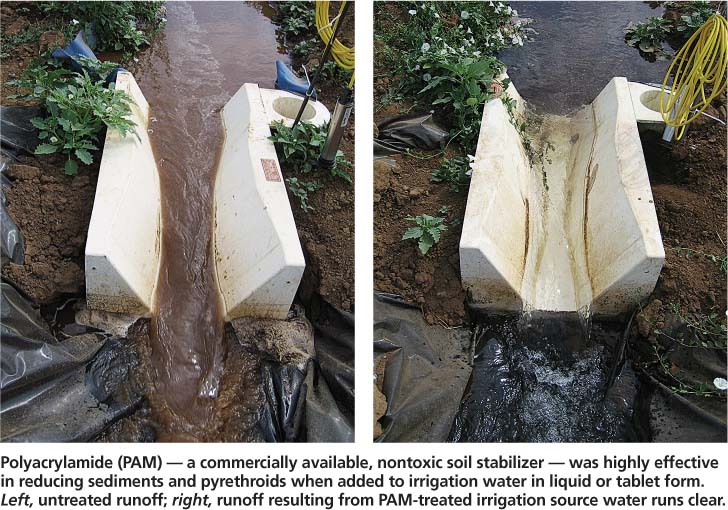All Issues
Mitigation techniques reduce sediment in runoff from furrow-irrigated cropland
Publication Information
California Agriculture 64(3):135-140. https://doi.org/10.3733/ca.v064n03p135
Published July 01, 2010
PDF | Citation | Permissions
Abstract
Irrigation tailwater can transport sediments and sediment-associated agricultural pollutants to nearby waterways. To help protect the biota of surface waters, we evaluated the use of polyacrylamide (PAM, a synthetic material that flocculates sediments when added to water), vegetated ditches and sediment traps to mitigate sediment losses from furrow-irrigated fields. In a 2-year study, liquid PAM injected into irrigation source water most effectively reduced suspended-sediment concentrations in runoff from different soil types. Dry tablet and granule PAM formulations were also effective, as long as their placement in the furrows promoted their dissolution in irrigation water. Vegetated ditches resulted in intermediate reductions in suspended sediments in tailwater. The sediment traps were limited in their effectiveness by insufficient holding time for fine-grained particulates to settle out of the runoff.
Full text
The erosion of soil from cropland and transport of sediments via irrigation runoff can degrade the quality of surface waters by increasing turbidity and sedimentation. Beyond the physical impacts of sediment itself, sediment particles may potentially carry nutrients and pesticides and degrade surface-water quality.
In California's Central Valley, for example, there are 11 water-body segments listed as “impaired” under the draft 2008 Clean Water Act Section 303(d) list, due to sediment toxicity of agricultural origin. Many other segments are impaired due to specific particle-associated pesticides, such as DDT, dieldrin, lindane and pyrethroids. Pyrethroid insecticides, in particular, are widely used in California agriculture and are commonly found in sediments in creeks and agricultural drains at concentrations toxic to sensitive aquatic species (Weston et al. 2004, 2008; Phillips et al. 2006). Pyrethroid insecticides are extremely water insoluble and bind tightly to finer particulate sediments. After being applied to fields, pyrethroids primarily move off-site attached to suspended sediments in irrigation and stormwater runoff (Gan et al. 2005).
Runoff from crop irrigation can cause sediment, nutrients and pesticides to flow into surface waters, degrading their quality. Above, a furrow-irrigated dry bean field in Chico was used to evaluate various methods of runoff mitigation to improve water quality.
Practices used successfully to retain soil on croplands and mitigate the transport of sediments to surface waters include the use of polyacrylamide (PAM, a liquid or solid material synthesized from propylene) added to water to stabilize the soil (Sojka et al. 2007), vegetated ditches (Bennett et al. 2005; Lacas et al. 2005; NRCS 2008; Moore et al. 2008) and sediment traps or basins that retain tailwater long enough to allow particles to settle (NRCS 2010). We evaluated PAM using a variety of application methods, and contrasted its effectiveness in concurrent trials with vegetated ditches and sediment traps.
Experimental sites and design
This project was conducted in 2006 and 2007 in furrow-irrigated fields at the University of California, Davis, and California State University, Chico. The Davis soil type was loam with 40.2% sand, 37.2% silt and 22.6% clay, and the Chico soil was clay loam with 27.7% sand, 46.6% silt and 25.7% clay. Both sites consisted of four to six plots with nine to 10 furrows spaced 5 feet apart (depending on the site and year) that were 600 feet long. Each plot was set up and managed separately so that irrigation inflow, tailwater, sediment and pesticide movement were measured independently. In both years, Davis was planted with processing tomatoes and Chico with lima beans.
Gated aluminum pipe (Davis) or polypipe (Chico) was used to deliver groundwater to the test plots at an average flow rate of 12 to 20 gallons per minute per furrow, with a turbidity reading of 3.5 nephelometric turbidity units (NTU). McCrometer (McCrometer, Inc., Hemet, Calif.) flow meters were used to measure the total irrigation water applied to each plot. Irrigation surface runoff from each plot flowed into a toe drain at the end of the furrows, then through either broad-crested weir flumes (Davis) or trapezoidal flumes (Chico) equipped with a stilling well (Plast-Fab, Inc. Tualatin, Ore.) and pressure transducer and data logger (Global Water Instrumentation, Gold River, Calif.) to measure the runoff flow rate every minute.
The irrigation tailwater was then directed into either an earthen (unvegetated) ditch to represent an untreated control, or into vegetated ditches or sediment traps, depending on the irrigation event and runoff treatment under evaluation. All runoff was then directed into a main drain that provided a holding area with no outlet to percolate the runoff and avoid any contamination of surface waters. The following treatments were evaluated and replicated in repeated irrigations to measure the impact on sediment reduction in furrow-irrigated crops.
Vegetated ditches 160 feet long, 5 feet wide and 8 inches deep were constructed in Chico and Davis, and planted with fescue sod (2006) or fescue and ryegrass seed (2007). Irrigation tailwater flowed through flumes and then into the ditch to capture sediment.
PAM. Treatments consisted of control plots (no PAM application) and liquid PAM injected into the irrigation water using an aqueous (PAM 25, 25% PAM, Terawet, San Diego, Calif.) or oil-based formulation (Soilfloc 300E, 37% PAM, Hydrosorb Inc., Orange, Calif.), and dry PAM formulations (Hydrosorb) using both granules (88% to 90% PAM) and tablets (40% PAM). The liquid PAM was injected into the source water by a peristaltic pump to achieve PAM concentrations (active ingredient) of usually 1 to 7 parts per million (ppm, or milligrams per liter), or up to 30 ppm in one trial.
In early trials, we placed PAM tablets and granules in the furrows within a few feet of the gated pipe at both sites, but the PAM was quickly buried due to turbulence and resulting soil erosion caused by the incoming water, rendering it ineffective. Subsequently, the PAM granules (1 or 2 ounces) or tablets (one or two) were placed in each furrow at either 100 feet, 300 feet or both distances from the gated pipe at the Davis site. This resulted in less turbulent flow and erosion and dissolved the PAM granules and tablets as the water flowed over them in the furrows. The concentration of dry PAM formulation in the surface runoff was 0.2 to 0.5 ppm, but was not determined in the water as it flowed down the furrows. Some of the PAM originally placed in the furrow was left over after each irrigation event. We did not investigate different dry PAM placements at the Chico site, but instead evaluated several methods of suspending PAM tablets in source water.
Water infiltration was calculated as the difference between the cumulative inflows and outflows during irrigation. We only discuss results of the 2007 PAM experiments because of problems with the liquid PAM injection in 2006.
Vegetated ditches. In 2006, three vegetated ditches 160 feet long by 5 feet wide and about 8 inches deep were established at both Davis and Chico with tall fescue sod (Festuca arundinacea). This ditch length was designed to handle the amount of tailwater expected for the scale of this study. In 2007, one vegetated ditch with similar dimensions was seeded with a mix of perennial ryegrass (Lolium spp.) and tall fescue at Chico the prior fall, at about 18 pounds (8 kilograms) per acre. For both sites and years, the grasses formed a thick thatch, visually covering nearly 100% of the ground. The irrigation tailwater flowed through the flumes, then through the vegetated ditch at or below the height of the grasses.
Sediment traps. In 2007, three sediment traps approximately 60 feet long, 2 feet deep (at the water line) and 6.5 feet wide with sloped sides were installed at each site. The traps provided about 60 to 90 minutes of holding time, which was sufficient for course particulates to settle out. In addition, the traps were lined with plastic to prevent sidewall sloughing.
Irrigation and sample collection
Each field site was irrigated once prior to evaluating the mitigation practices, and sediment in the runoff was found to contain no detectable pyrethroids (< 1 nanogram per gram). Subsequently, the fields were cultivated and a pyrethroid insecticide was applied at each site at recommended field rates. Lambda-cyhalothrin (Warrior) was used at Davis at 0.03-pound active ingredient per acre, and zeta-cypermethrin (Mustang) was used at Chico at 0.05-pound active ingredient per acre. Within a few days of insecticide application, the experimental fields were irrigated and runoff was collected under the different mitigation practices. Each irrigation event included a control plot with no mitigation. This process (field cultivation, pesticide application and irrigation, unless otherwise noted) was repeated with five to six irrigation events per growing season.
Tailwater samples were collected from each plot approximately every 30 minutes from the onset of surface runoff until the water was turned off and flow had nearly ceased. Water samples were collected from the control and PAM plots just above the flumes used to measure surface runoff flow rates. For the vegetated ditches and sediment traps, tailwater samples were collected both before and after runoff passed through the mitigation measure. Water samples (16.9 ounces [500 milliliters]) were taken for total suspended-sediment concentrations and analyzed by filtering a known volume of water on a Whatman 934-AH glass fiber filter and weighing the dry particulate matter retained on the filter. The suspended-sediment-concentration data was combined with the flow measurements to estimate the average flow-weighted suspended-sediment concentration when integrated over the entire irrigation event. Suspended sediment was also collected by continuous-flow centrifugation of large-volume water samples (10 to 60 gallons [37.8 to 227 liters]), and the pyrethroid content was analyzed by the methods of You et al. (2008).
Sediment mitigation comparison
Suspended-sediment concentrations. Suspended-sediment concentrations in the control treatments (no mitigation) were highest for the first irrigation event at both Chico and Davis and declined with subsequent events during the season. They also were highest at the start of surface runoff for each irrigation event and decreased over time. For example, concentrations at Davis typically were 0.5 to 2 grams per liter at the beginning of each irrigation and declined to 0.1 to 0.3 gram per liter. At Chico, initial concentrations were 1 to 4 grams per liter and 0.3 to 0.7 gram per liter in the later stages of an irrigation.
The duration of the irrigation events ranged from 228 to 314 minutes at Davis and 260 to 435 minutes at Chico. Maximum tailwater flow rates ranged from 80 to 90 gallons per minute at Davis (43% average runoff) and 30 to 72 gallons per minute at Chico (18.9% average runoff). The runoff rates were more variable at Chico, depending upon whether and how deeply or lightly the soils were cultivated.
PAM. Liquid PAM at concentrations of about 2.1 ppm (estimated from PAM injection and irrigation-water flow rates) greatly reduced suspended-sediment concentrations (fig. 1). In subsequent irrigation events, both liquid PAM (about 5 ppm) and PAM tablets placed 300 feet down the furrow substantially reduced sediment concentrations (fig. 2). For the tablets, the initial sediment concentrations were higher shortly after runoff began, but after about 50 minutes the sediment concentrations were similar for both liquid and dry PAM formulations.
Suspended-sediment concentrations were similar for both PAM tablets and granules during the Aug. 14 irrigation at Davis (fig. 3). Dry PAM placed at both 100 feet and 300 feet down the furrow from the source water was slightly more effective compared to a single-location placement, but this result was not consistent during other irrigation events (table 1).
Fig. 1. Suspended-sediment concentrations (g/L) in irrigation tailwater during individual irrigation events for control (no PAM) and liquid PAM at about 2.1 ppm in source water, Chico and Davis, 2007.
Fig. 2. Suspended-sediment concentrations (g/L) in irrigation tailwater during one irrigation event for control (no PAM), liquid PAM at about 5 ppm in source water, and two PAM tablets per furrow placed at 300 feet from the gated pipe delivering the source water, Davis, 2007.
Fig. 3. Suspended-sediment concentrations (g/L) in irrigation tailwater during one irrigation event for control (no PAM) and two PAM tablets, or 2 ounces of PAM granules, per furrow placed at 100 feet, 300 feet or both distances from the gated pipe delivering the source water, Davis, 2007.
In 20 combined PAM trials (15 at Davis, five at Chico) involving liquid and dry PAM (excluding placements at the head of the furrows and tablet suspensions in the water), the percent reductions in total sediment load due to the PAM treatments ranged from 57% to 92% (table 1). In 60% of the trials, suspended-sediment concentrations were reduced more than 80%, and more than 90% in 25% of the trials.
TABLE 1. Suspended-sediment reduction in irrigation tailwater with different polyacrylamide (PAM) treatments, Davis and Chico, 2007
PAM concentrations ranging from 1.1 to 30 ppm in the source water achieved sediment reductions between 57% and 92% (table 1). The smaller value resulted from terminating the PAM injection when the source water reached the end of the furrows, after which sediment concentrations increased to those of the control. The average sediment reductions of liquid (86.7%) versus dry (77.9%) PAM treatments were statistically indistinguishable (t-test = 0.05, P = 0.108). The number of placements for dry PAM in the furrows was also statistically indistinguishable (P = 0.217) with sediment reduction values of 73.6% and 83.0% for the single- versus two-placement treatments, respectively.
Suspending PAM tablets in the source irrigation water at the Chico site reduced the sediment load, but these treatments were not very effective compared to liquid PAM (table 1). Previous applications of PAM, in soil left undisturbed, reduced the sediment load in a subsequent irrigation by 45.4% at Davis and 47.8% at Chico (table 1). No statistically significant differences were found in the infiltrated amounts of water between the control and PAM-treated plots (Davis P = 0.419; Chico P = 0.925). The average infiltration was 0.89 inch for the control and 0.98 inch for PAM at Davis, and 1.85 inches for both the control and PAM at the Chico site.
Vegetated ditches. Combining results from Chico and Davis, the vegetated ditches significantly reduced total suspended sediments by 62% at 160 feet (P < 0.1, n = 9, analysis of variance [ANOVA]) (fig. 4). There was a gain in sediments in the earthen ditch due to erosion within the ditch, though nonsignificant (P > 0.1, n = 7, ANOVA). The average total suspended-sediment concentration was 0.34 gram per liter at the beginning of the vegetated ditch compared to 0.13 gram per liter at 160 feet. A typical irrigation of about 5 hours in our study resulted in an average of 42 pounds [19 kilograms] of sediment moving from the field to the head of the vegetated ditches. As the tailwater flowed through the vegetated ditches, 62% (26 pounds [12 kilograms]) of the total sediment was removed per irrigation event.
Sediment traps. In 2007, the sediment traps significantly reduced suspended sediments by 39% in the first irrigation event (P < 0.05, n = 3, ANOVA) but not in the second or later irrigation events (fig. 5). For the first irrigation event, the average sediment level above the traps was 0.98 gram per liter compared with 0.60 gram per liter below the traps. For the subsequent irrigation events, the average sediment level above the traps was 0.21 gram compared with 0.19 gram per liter below the traps (P > 0.05, n = 3, ANOVA). With an average of 51 pounds [23 kilograms] of sediment (all sites and years combined) reaching the sediment traps during our typical 5-hour irrigation, the trap retained 39% of this sediment (20 pounds [9 kilograms]) in the first irrigation, and almost none in the second and later irrigations.
Pyrethroid chemistry
Background concentrations of lambda-cyhalothrin and zeta-cyperme-thrin in suspended sediment in surface runoff at both Chico and Davis, prior to applying these insecticides in our trials, were below the minimum detection level of 1 nanogram per gram in both years of our study. After applying the pesticides, for all treatments combined, the lambda-cyhalothrin-treated plots at Davis had a median concentration of 431.5 nanograms per gram of dry sediment in the surface irrigation runoff, whereas runoff from the zeta-cypermethrin-treated plots contained 162.5 nanograms per gram.
There were no statistically significant differences in pyrethroid concentrations between the different treatments (P > 0.05). The treatments altered suspended-sediment concentrations, but not the pyrethroid concentration on that sediment. As a result, the reduction in particle-adsorbed pyrethroid achieved by the different treatments was equivalent to the amount of sediment reduced by the different treatments during an irrigation event. This relationship assumes that the vast majority of pyrethroid is present on the suspended sediment rather than dissolved in the water, a reasonable assumption given the strong tendency of these insecticides to bind to soils and be transported with suspended sediments.
Reducing sediment in runoff
Both the liquid and dry PAM formulations were highly effective in reducing sediment losses in surface runoff, with a reduction of more than 80% in suspended-sediment loads with most uses. Water-based liquid PAM is recommended because it is nontoxic, whereas carriers in the oil-based PAM are toxic to some aquatic invertebrates sediment-associated pollutants through sedimentation, soil infiltration and adsorption of pesticides on plant surfaces. These pollutants are then mostly degraded to nontoxic forms by physical and microbial processes (Lacas et al. 2005; Moore et al. 2008).
When vegetated ditches are installed on farms, they should be wide and dense enough to maintain a shallow, sheetlike flow depth at or below the vegetation height to provide adequate contact between flowing water and vegetation. In our trials with surface runoff ranging from 30 to 90 gallons per minute from the field, a 160-foot-long by 5-foot-wide, grass-filled ditch with a water depth of about 5 inches was sufficient to reduce sediments in irrigation tailwater by 62%.
Fig. 4. Suspended-sediment concentrations (g/L) in irrigation tailwater in vegetated ditches compared with an earthen (unvegetated) ditch. Suspended sediments were significantly reduced by 62% in ditches at 160 feet, whereas unvegetated ditches showed a gain (though nonsignificant) in sediments due to soil erosion.
Fig. 5. Suspended-sediment concentrations (g/L) in irrigation tailwater at the sediment trap inlet and outlet. Suspended sediments were significantly reduced by 39% in the first irrigation, but not in second and later irrigation events.
In this study, traps reduced sediment in surface runoff after the first irrigation but not subsequent irrigations. The efficacy of this mitigation technique will depend on soil types and runoff flow rates.
The sediment traps resulted in some sediment reductions in surface runoff in the first irrigation but not in subsequent irrigation events. Such traps function by temporarily retaining irrigation surface runoff, which reduces the flow velocity and turbulence, and enables suspended sediments to settle out. Coarser-grained or larger-aggregated soil particles settle out of the runoff much more rapidly than finer-grained silt and clay particles, on which the majority of pyrethroids or other sediment-associated pesticides would be carried. As a result, the efficacy of the traps will depend on soil types and flow rates.
With higher flow rates and siltyloam soils, the retention time in sediment traps was not high enough in our study to retain the water long enough to allow the fine silts to settle out before the water was released into drains. In these cases, larger tailwater ponds or return systems would be recommended. The sediment traps may have been more effective during the first irrigation event in our trials because the disruption in aggregate stability, particularly in the beginning of the season when fields are extensively cultivated for planting, resulted in higher levels of coarser particulates coming off fields, though we did not measure particle-size distributions in our traps.
PAM is commercially available, and costs per acre are within reason. Growers are already using it to mitigate sediment loss from furrow-irrigated fields; ours is the first study that shows it can be used to mitigate pyrethroids. Vegetated ditches and sediment traps are also being used on some California farms for this purpose.
Polyacrylamide (PAM) — a commercially available, nontoxic soil stabilizer — was highly effective in reducing sediments and pyrethroids when added to irrigation water in liquid or tablet form. Left, untreated runoff; right, runoff resulting from PAM-treated irrigation source water runs clear.
The use of PAM, vegetated ditches and/or sediment traps will help prevent sediments and sediment-associated pesticides such as pyrethroids from moving off-site in irrigation tailwater. However, the degree to which these mitigation practices protect water quality will depend on soil type and the volume and velocity of the tailwater. As a result, site-specific guidelines will need to be developed and implemented for individual farms to best protect water quality when irrigation runoff occurs in furrow-irrigated crops, as found in Long et al. (2010).




